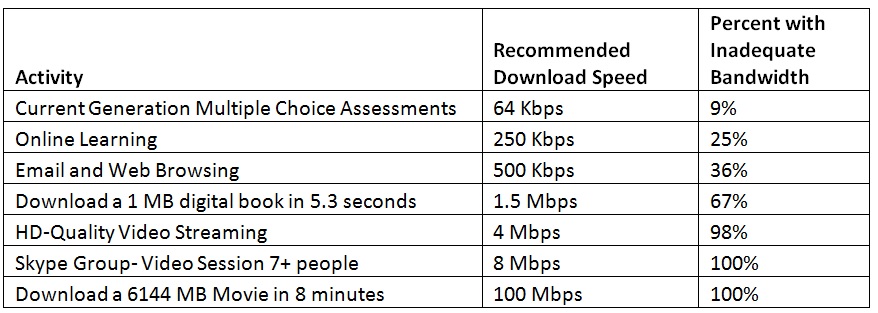Leaders from industry, education, and the Oval Office have highlighted the need for expanded broadband access. President Obama made specific bandwidth goals the centerpiece of his ambitious ConnectEd Initiative. Unfortunately, there is a dearth of data on Internet speeds in schools. Data from Verizon can help to provide insight into questions about Internet connectivity in the nation’s schools. The data suggest that many schools don’t have access to enough bandwidth.
How Much Bandwidth Does a School District Need?
Schools require differing amounts of bandwidth depending on their use of education technology and the number of students. Every school should have Internet connections that allow all students to use basic Internet features like web browsing and email. In addition every school should have the capacity to administer exams on computers that rely on Internet access. Schools ought to use the Internet for much more but districts without these capacities lack necessary tools for communicating in the twenty first century.
Verizon combined publically available information on school Internet access along with data from their school district customers. Their data covers over 300 school districts from 12 states (including Washington DC) and about 4.5 million students or approximately 8 percent of the entire primary and secondary school population. They counted the number of connections for each school district divided into three bandwidth categories: greater than 10 megabytes and less than 100 megabytes, greater than 100 megabytes and less than 1,000 megabytes, and greater than 1,000 megabytes. To determine a rough estimate of kilobytes per student we assumed an average bandwidth for each category of 100 megabytes, 500 megabytes, and 1,000 megabytes and divided by the number of students in the district.
School District Education Technology Capacity by Activity

Source: Authors Calculation
The average number of kilobytes per student was 946 (1,000 kilobytes equals 1 megabyte) and the median was 1,136. The standard deviation was 989 kilobytes per student. This means that bandwidth per student varies greatly from district to district. The chart above shows the percentage of schools that could support different education activities. The recommended download speeds are based on a report from the State Educational Technology Directors Association. The figure assumes every student is using a service simultaneously. It is clear from the data that about one out of 10 school districts does not have the bandwidth to use applications that require modest Internet download speeds.
This change has important implications as districts switch over to the Common Core tests which are taken on a computer and require Internet access. If the United States does not improve its’ education infrastructure then it will fall further behind its global competitors. The ConnectEd initiative set a goal that within five years, 99 percent of American students will have access to next-generation broadband at speeds of no less than 100 megabytes per second with a target of 1,000 megabytes per second. Many school districts have connections that exceed those targets today, but far too many do not. Greater urgency to upgrade America’s classrooms is necessary now.



Commentary
How Big is the School Broadband Gap?
May 21, 2014